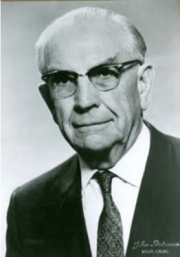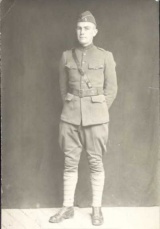Victor A. Endersby: Difference between revisions
No edit summary |
|||
| Line 3: | Line 3: | ||
'''Victor A. Endersby''' (1891-1987) was an American Theosophist. He served as editor of [[Theosophical Notes (periodical)|''Theosophical Notes'']] and contributed many articles to [[Theosophy (periodical)|''Theosophy'']]. With Henry Geiger, he founded the magazine [[Manas (periodical)|''Manas'']] in 1948 in a weekly format. He and his wife Frances were members of the U. L. T.'s [[Dzyan Esoteric School]], and he was also involved with the [[Theosophy School]].<ref>Jerry Hejka-Ekins, "Victor A. Endersby, A Pioneering Independent Theosophist," ''Keeping the Link Unbroken'' (New York: Theosophical Research Monographs, 2004), 126-150.</ref> | '''Victor A. Endersby''' (1891-1987) was an American Theosophist. He served as editor of [[Theosophical Notes (periodical)|''Theosophical Notes'']] and contributed many articles to [[Theosophy (periodical)|''Theosophy'']]. With Henry Geiger, he founded the magazine [[Manas (periodical)|''Manas'']] in 1948 in a weekly format. He and his wife Frances were members of the U. L. T.'s [[Dzyan Esoteric School]], and he was also involved with the [[Theosophy School]].<ref>Jerry Hejka-Ekins, "Victor A. Endersby, A Pioneering Independent Theosophist," ''Keeping the Link Unbroken'' (New York: Theosophical Research Monographs, 2004), 126-150.</ref> | ||
[[ | == Personal life and career == | ||
Victor Arthur Endersby was born on [[December 19]], 1891 in a ranch house in Augusta, Montana. Alvadus Oden Endersby, his father, was a cattle rancher married to Mary Elizabeth Cook, a school teacher. In addition to Victor, they had two younger sons. His family moved north in 1895, and settled in an area of southern Alberta, Canada that was then part of the North West Territories.<ref>1901 Census of Canada.</ref> The entire family worked hard at their cattle ranch and in other efforts to earn a living, and schooling for the boys was sporadic. Victor was largely self-taught until the family sold their cattle and moved to Northern California, where he was able to attend school. He was able to enter college at Stanford University, where he completed an engineering degree in 1916.<ref>Hejka-Ekins, 129.</ref> | |||
His career began in working on roads in the California redwood country, and then at the Coast and Geodetic Survey in Alaska. the First World War intervened, and he was in the U. S. Army from 1917-1918. | |||
<blockquote> | <blockquote> | ||
He served in France where he carried with him a translation of the [[Bhagavad Gita (book)|''Bhagavad Gita'']] and [[The Ocean of Theosophy (book)|''The Ocean of Theosophy'']], and returned with the rank of "Captain of Engineers."<ref>Hejka-Ekins, 129.</ref> | |||
</blockquote> | |||
On June 3, 1925, Victor married Frances Holman. They moved to California and settled in Contra Costa. They had four children: Florence, Elena, Keith, and Sandra.<ref>1940 United States Census.</ref> | |||
Mr. Endersby was a civil engineer, whose special expertise was in road and bridge construction. "His crowning achievement was as Chief Engineer for the eastern half of the San Francisco Bay Bridge."<ref>"Victor Endersby" ''The Canadian Theosophist'' (January-February, 1989), 139-140.</ref> He later engaged in engineering research for Shell Oil Company. He was published in the ''Encyclopedia of Chemical Technology'' and in the 1964 edition of ''Encyclopedia Britannica''. After retirement in 1953, "he continued to work as a consultant and investigator into the 1970s."<ref>Hejka-Ekins, 130.</ref> | |||
Mr. Endersby died on [[November 8]], 1988 in Napa, California at the age of 96. His ashes were scattered in the Pacific Ocean.<ref>[https://www.findagrave.com/memorial/182629268/victor-arthur-endersby Victor Arthur Endersby in U. S. Findagrave]. Accessed March 30, 2020.</ref> | |||
== Involvement with Theosophy and Theosophists == | |||
Victor was acquainted with Theosophists from a young age: | |||
<blockquote> | |||
A major influence in the life of the young Victor was a colourful individual who lived just a few miles from the Endersbys. This was John "Kootenai" Brown, an early Canadian Theosophist who was to become the first Superintendent of the nearby Waterton Lakes National Park. He allowed the boy to borrow books from what eighty years later the man remembered was a "remarkable library". Victor's uncle, Ted Endersby, was also a member of the Theosophical Society at that time.<ref>"Victor Endersby" ''The Canadian Theosophist'' (January-February, 1989), 139-140.</ref> | |||
</blockquote> | </blockquote> | ||
Brown loaned books to young on science, literature, and religion, but held back the Theosophical texts until the boy was older, saying "They were for grownups."<ref>Hejka-Ekins, 129.</ref> As a college sophomore in 1912, Victor encountered ''The Ocean of Theosophy'' and ''The Secret Doctrine''. | |||
<blockquote> | |||
Encouraged by findings in these books, he became acquainted with the nearby Halcyon Theosophical group, The [[Temple of the People]], and other Theosophical organizations where he began attending meetings while going to school."<ref>Hejka-Ekins, 129.</ref> | |||
</blockquote> | |||
<blockquote> | |||
From an early age, he was a deeply serious student of Theosophy, and active in its cause. In 1950 he launched his own journal, ''Theosophical Notes'', which he wrote and published privately until 1978. At this stage he was independent of Theosophical organizations, though generally respected by all, and his journal helped forge links with others of like mind in several countries; he especially enjoyed the friendship and support of several prominent Canadian Theosophists in the 1950s and 1960s. Among his other publications worthy of note is ''The Hall of Magic Mirrors (1969), a defence of Madame Blavatsky''.<ref>"Victor Endersby" ''The Canadian Theosophist'' (January-February, 1989), 139-140.</ref> | |||
</blockquote> | |||
== Theosophical writings == | == Theosophical writings == | ||
Revision as of 16:14, 2 April 2020
Victor A. Endersby (1891-1987) was an American Theosophist. He served as editor of Theosophical Notes and contributed many articles to Theosophy. With Henry Geiger, he founded the magazine Manas in 1948 in a weekly format. He and his wife Frances were members of the U. L. T.'s Dzyan Esoteric School, and he was also involved with the Theosophy School.[1]
Personal life and career
Victor Arthur Endersby was born on December 19, 1891 in a ranch house in Augusta, Montana. Alvadus Oden Endersby, his father, was a cattle rancher married to Mary Elizabeth Cook, a school teacher. In addition to Victor, they had two younger sons. His family moved north in 1895, and settled in an area of southern Alberta, Canada that was then part of the North West Territories.[2] The entire family worked hard at their cattle ranch and in other efforts to earn a living, and schooling for the boys was sporadic. Victor was largely self-taught until the family sold their cattle and moved to Northern California, where he was able to attend school. He was able to enter college at Stanford University, where he completed an engineering degree in 1916.[3]
His career began in working on roads in the California redwood country, and then at the Coast and Geodetic Survey in Alaska. the First World War intervened, and he was in the U. S. Army from 1917-1918.
He served in France where he carried with him a translation of the Bhagavad Gita and The Ocean of Theosophy, and returned with the rank of "Captain of Engineers."[4]
On June 3, 1925, Victor married Frances Holman. They moved to California and settled in Contra Costa. They had four children: Florence, Elena, Keith, and Sandra.[5]
Mr. Endersby was a civil engineer, whose special expertise was in road and bridge construction. "His crowning achievement was as Chief Engineer for the eastern half of the San Francisco Bay Bridge."[6] He later engaged in engineering research for Shell Oil Company. He was published in the Encyclopedia of Chemical Technology and in the 1964 edition of Encyclopedia Britannica. After retirement in 1953, "he continued to work as a consultant and investigator into the 1970s."[7]
Mr. Endersby died on November 8, 1988 in Napa, California at the age of 96. His ashes were scattered in the Pacific Ocean.[8]
Involvement with Theosophy and Theosophists
Victor was acquainted with Theosophists from a young age:
A major influence in the life of the young Victor was a colourful individual who lived just a few miles from the Endersbys. This was John "Kootenai" Brown, an early Canadian Theosophist who was to become the first Superintendent of the nearby Waterton Lakes National Park. He allowed the boy to borrow books from what eighty years later the man remembered was a "remarkable library". Victor's uncle, Ted Endersby, was also a member of the Theosophical Society at that time.[9]
Brown loaned books to young on science, literature, and religion, but held back the Theosophical texts until the boy was older, saying "They were for grownups."[10] As a college sophomore in 1912, Victor encountered The Ocean of Theosophy and The Secret Doctrine.
Encouraged by findings in these books, he became acquainted with the nearby Halcyon Theosophical group, The Temple of the People, and other Theosophical organizations where he began attending meetings while going to school."[11]
From an early age, he was a deeply serious student of Theosophy, and active in its cause. In 1950 he launched his own journal, Theosophical Notes, which he wrote and published privately until 1978. At this stage he was independent of Theosophical organizations, though generally respected by all, and his journal helped forge links with others of like mind in several countries; he especially enjoyed the friendship and support of several prominent Canadian Theosophists in the 1950s and 1960s. Among his other publications worthy of note is The Hall of Magic Mirrors (1969), a defence of Madame Blavatsky.[12]
Theosophical writings
The Union Index of Theosophical Periodicals lists over 900 articles by Victor Endersby. He also wrote these books:
- Basic Theosophy. 1969.
- Battle royal of Hodgson versus Hartmann versus Waterman refereed by the Editor of Theosophical Notes. 1964.
- The Hall of Magic Mirrors. Carlton Press, 1969. A biography of H. P. Blavatsky.
- "On the Work and Teachings of Alice Bailey" in BlavatskyTheosophy.com website. This first appeared in Theosophical Notes, September 1963. It was written by Victor Endersby as part of his "A Study of the Arcane School of Alice A. Bailey."
Fiction writings
Mr. Endersby wrote some short stories.
- "Disowned."
- "Neighbors." This story is available at this website.
Additional resources
- Correspondence and other archival materials are held at Alexandria West Library.
Notes
- ↑ Jerry Hejka-Ekins, "Victor A. Endersby, A Pioneering Independent Theosophist," Keeping the Link Unbroken (New York: Theosophical Research Monographs, 2004), 126-150.
- ↑ 1901 Census of Canada.
- ↑ Hejka-Ekins, 129.
- ↑ Hejka-Ekins, 129.
- ↑ 1940 United States Census.
- ↑ "Victor Endersby" The Canadian Theosophist (January-February, 1989), 139-140.
- ↑ Hejka-Ekins, 130.
- ↑ Victor Arthur Endersby in U. S. Findagrave. Accessed March 30, 2020.
- ↑ "Victor Endersby" The Canadian Theosophist (January-February, 1989), 139-140.
- ↑ Hejka-Ekins, 129.
- ↑ Hejka-Ekins, 129.
- ↑ "Victor Endersby" The Canadian Theosophist (January-February, 1989), 139-140.

